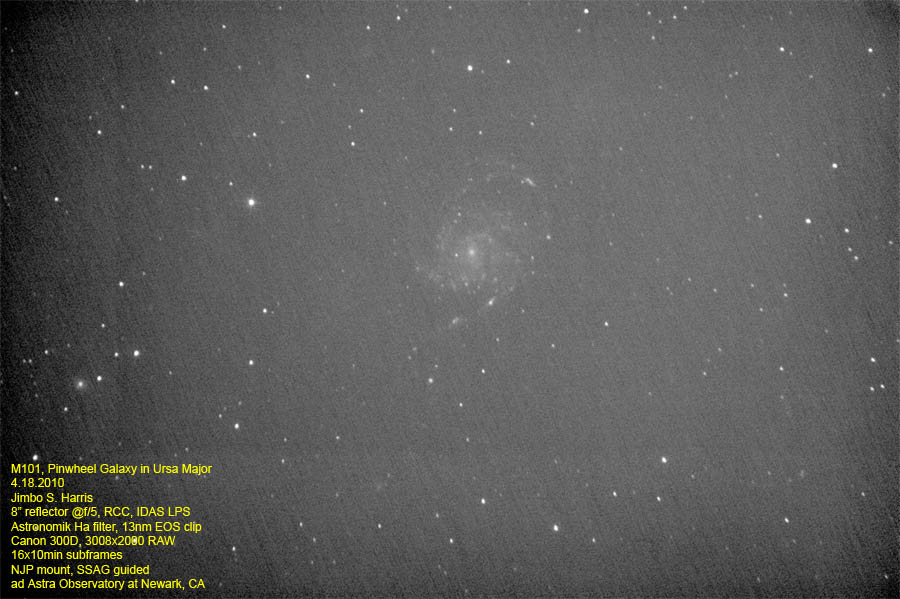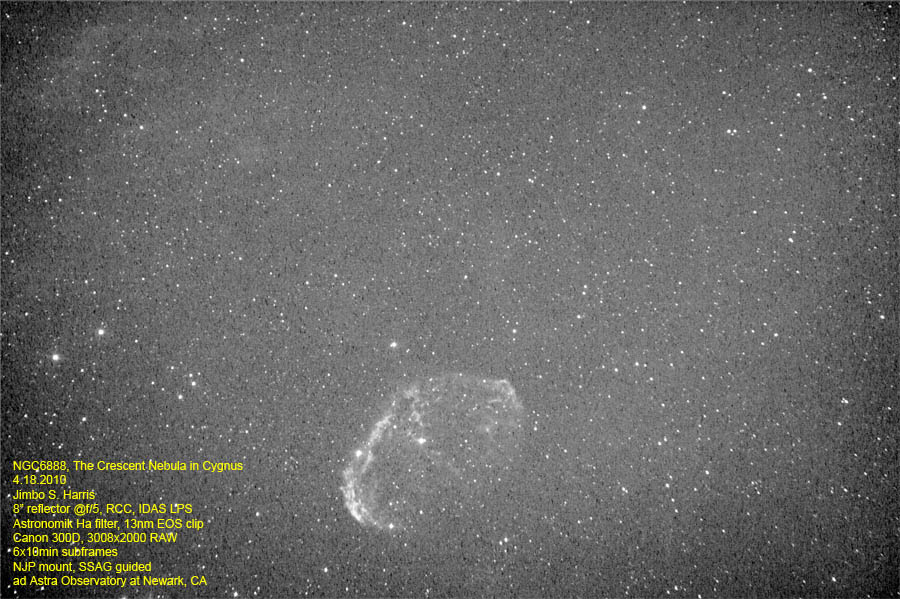Buoyed with the success of the NJP with Pumpkin, I decided to start upping the ante. Pumpkin was mounted offset to one side, but I decided that Veronica should be balanced over the Dec axis. I was already a little concerned whether the DA’s would hold Veronica, and I wanted one less thing to worry about regarding balance. So I reworked the DA’s so they’d fit in the center of the mounting plate, and mounted up Veronica.
At the same time, I decided to mount a couple of finder dovetails on the mounting plate, so I would have a place to mount Guido. That was a measured success; it totally worked for guiding (see guide data below), but was not so cool for using Veronica’s finder; something I’ll fix presently.
Here’s the guide data. The mount is so smooth, it’s silly.
I had been having trouble last night with subframe length; skyglow was eating any images longer than 3 minutes. I wanted to test some 10m and 20m subframes, so I decided to add the Ha filter to the mix. This made focusing a challenge, although the 3-day moon did help out some by staying up late enough that I could use it as a focus target.
Getting FocusMax working again was a bit of a pain. It took about 2 hours (or 3?) before I was up and running and ready to start guiding.
The winter nebulae had set by then (it was about 11:30 or so), and the spring ones weren’t due up for hours, so I decided to run the Ha filter on the spring galaxies. M101 was the target of choice; because the polar alignment isn’t exactly perfect, my “bracketing” exposures missed the galaxy (because the GOTO was inaccurate; I need to add “re-synch on nearby star” to my workflow habit). Once I resynched, Temma put M101 on the CCD.
The bracketing exposures showed that 10m exposures were fine, but 20m are a little too long (I’ll work out later whether 15m can be done).
I had earlier figured out that I can go about 2 hours, 10 min. past Meridian before hitting the pier. I set this up in the mount safety limits, but I still need to make sure that’s actually doing something.
Because I was 30 min. before the Meridian, I set it up to run for 2.5 hours (20x10m exposures, allowing for download time), set an alarm clock, and took a nap. At 3:30a (yes, it took awhile to get started), I went out, to find that the telescope had hit the pier. It actually hit the pier during the last exposure before I got up, though, so not too bad.
I crunched the data once I woke up, and here’s what I got. I think that my data processing workflow could use some help; I stacked this using “SD Mask”, for reasons passing understanding, and got some strange diagonal noise added.
But, this is 16x10m images, 2h 40m total, of M101 in Ha through Veronica.
I re-synched the mount on a star rising in the East (Deneb), and slewed to NGC6888 to see how Veronica could do on a “real” Ha object. I set it up to run for 3 hours (18x10m), knowing that I would be up by 6:30a to turn everything off.
I went to bed, had a crazy bad dream about the mount running into the roof and somehow falling into a lake (wow), and woke up to the mount having lost the guide star because of the sunrise. I only lost one image there, too. Not bad again!
I was a little off on the GOTO again; it was 3:30 in the morning, give me a break. I only got 6 useable subframes of NGC6888; I think a cloudbank hit at some point in there.
NGC 6888, The Crescent Nebula in Cygnus, 6x10m, one hour total exposure, Ha
A reminder that the reason these are grayscale is that this is the red channel only, as the Ha filter only lets data into the red channel.
So, my impressions?
First, the NJP is absolutely destroying my circadian rhythm. I am so tired I could sleep standing up right now.
Second, the mount is so stupidly accurate that I don’t know what to do with myself. The first time I tried to cut the guiding data this morning, PemPro reported a PE curve of +/- 0.0. When I look at the raw data, other than the big jumps that happen in Dec whenever the shutter trips, all of the data falls between 0.0 and 0.4 pixels. From the previous night’s data, I had an RMS periodic error of about +0.3/-0.2, or a swing of about 0.5″. Tonight’s data looks similar. That’s a 20x improvement over the best performance I ever achieved with the G-11 (+/- 5″, 10″ peak-to-peak). NJP good? I’m sold.
Third, I think the RCC is a lost cause. It makes my telescope hard to collimate, and it doesn’t seem to do as nice of a job flattening the field as the MPCC does (take a look at the corners of the images). Now that I am using clip-in filters, and have a mount that is really guideable, I think that I’m ready to pull the RCC, get Veronica reset back to normal, and use the MPCC from here on out.
Fourth, I don’t know whether the IDAS LPS and Ha filter are not behaving properly together, or whether my optics need cleaning, or dew prevention, or image processing, or what, but these images seem a lot noisier and generally uglier than the Ha stuff I was doing last spring. I’ll get my Ha mojo back, just something to note.
Finally, I can’t wait to see what the mount can do once I’ve aligned it properly! Unguided? Crazy long focal lengths? Oh, I think we’re going to find out. Stay tuned.




These stars are round ……
Out of 22 useable subframes, each one 600sec long, I did not lose a single frame to guiding errors. I didn’t see any evidence of guiding errors in the 20m subframe either, it just saturated from skyglow.